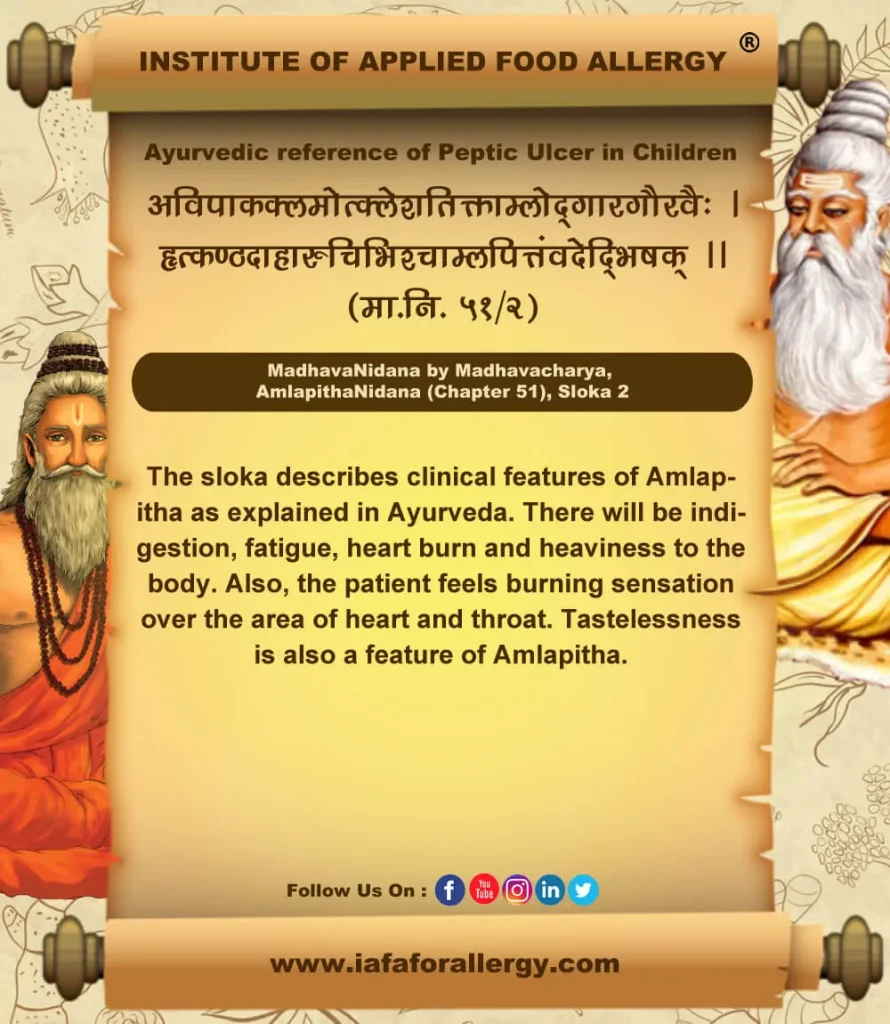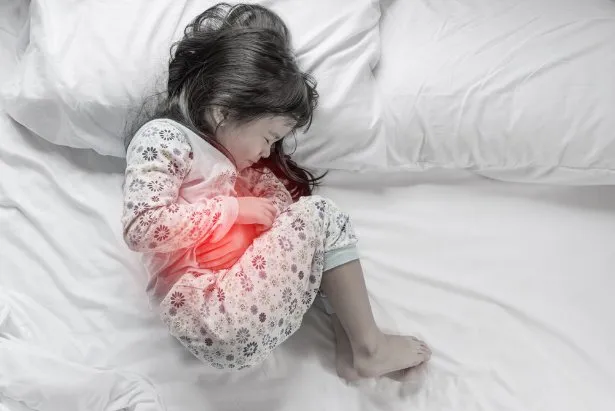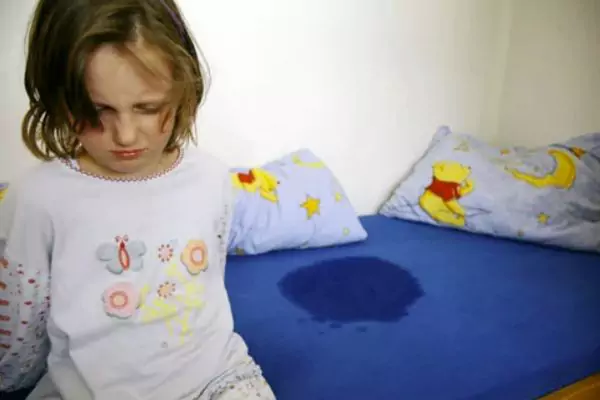On This Page
What is Peptic Ulcer in Children?
An ulcer is an open, painful wound. Peptic ulcers can form in the stomach or over the upper region of the small intestine called duodenum. An ulcer in the stomach is known as gastric ulcer and an ulcer in the duodenum is called as duodenal ulcer. Both can occur when the protective mucous coating of the stomach and duodenum get weakened and acid enters into the lining. This can lead to the formation of an ulcer. Peptic ulcer refers to both these types of ulcers. People of any age like children, young adults or even old people can get affected with peptic ulcer. In Ayurveda, similar condition is explained as Amlapitta.
Causes of Peptic Ulcers in Kids
Important causes for the occurrence of peptic ulcer in children include:
- Infection by bacteria called Helicobacter pylori
- Mental stress
- Certain food items
- Use of some Non-steroidal anti-inflammatory drugs (NSAIDs) such as ibuprofen.
- Certain medical conditions
- Severe burns
- Sepsis by bacterial infection
Signs and Symptoms of Peptic Ulcers
Peptic ulcers are usually rare in kids. But, following signs and symptoms should be noticed:
- Burning sensation or pain in the abdomen, especially over the area between the chest and the belly button
- Nausea
- Vomiting
- Dull and achy chest pain
- Loss of appetite
- Frequent burping or hiccupping
- Weight loss
- Feeding difficulties
- Blood in vomit or stool
Ayurvedic Reference of Peptic Ulcer in Children (Amlapitta)
अविपाकक्लमोत्क्लेशतिक्ताम्लोद्गारगौरवै: l
हृत्कण्ठदाहारुचिभिश्चाम्लपित्तंवदेद्भिषक् ll


“Dr. Gupta’s IAFA offers effective treatment for peptic ulcer in children. Institute of Applied Food Allergy® is a quality health care centre that offers the best Ayurvedic treatment for various diseases. IAFA is always dedicated in providing remedial measures required by each individual based on their physical, mental and emotional status.
Hold IAFA for ensuring a healthy life !!
– Dr. Sahil Gupta (B.A.M.S., M.H.A.)
Ayurvedic Allergy Specialist
CEO & Founder of IAFA®
At last, Easier Peptic Ulcer Management

Trusted by
More than 90,000 Patients

Convenient
at-Home Treatments

9.2 / 10
Customer Satisfaction Score
Ayurvedic Treatment of Peptic Ulcer in Children
Ayurveda put forwards effective treatment for ear infection by combining internal medicines and external therapies.
Internal Medicines for Peptic Ulcer in Children
- Guluchyadi Kashaya
- Gandharvahastadi Kashaya
- Mahatiktaka Kashaya
- Panchatiktaka Kashaya
- Avipathy Choorna
- Dhanwantaram Gulika
- Hingutriguna Taila
- Dadimadi Ghrita
- Vilwadi Lehya
- Dashamoola Haritaki Lehyam
- Sankha Bhasma
- Triphala Lauha
Treatment Procedures for Peptic Ulcer in Children
- Mridu Virechana (Light Purgation)
- Ksheeravasti (enema with medicated milk)
Single Herbs in the Management of Peptic Ulcer in Children
- Haridra (Curcuma longa)
- Vasa (Adhatoda vasica)
- Guduchi (Tinospora cordifolia)
- Eranda (Ricinus communis)
- Yashtimadhu (Glycyrrhiza glabra)
- Nimba (Azadirachta indica)
- Patola (Trichosanthes dioica)
- Satavari (Asparagus racemosus)
- Punarnava (Boerhavia diffusa)
Diet in Peptic Ulcer in Children
Pathya (Do’s)
- Fruits like apple, pear etc.
- Oatmeal
- Sweet potato
- Cauliflower
- Cabbage
- Radishes
- Strawberries
- Cherries
- Carrots
- Light and easily digestible food
- Take food at regular timings
- Green gram
- Take vegetables with bitter taste
- Mild exercises
- Take enough rest
Apathya (Don’ts)
- Coffee, tea, sodas
- Chocolate
- Spicy food
- Alcohol
- Acidic foods, such as citrus and tomatoes
- Artificial juices
- Over the counter NSAIDs
- Fried and bakery food
- Late breakfast
- Skipping food
- Sleeplessness
- Mental strain & tension
Yoga and Pranayama in Peptic Ulcer in Children
Yoga practice helps in improving strength of body’s immunity.
- Savasana
- Padmasana
- Suryanamskar
- Pavanamuktasana
- Bhujangasana
- Makarasana
- Simhasana
Pranayama provides control over body movements. It helps to prepares mind to face discomforts.

Frequently Asked Questions
Question: What are the causes of peptic ulcer?
Answer: Peptic ulcer is caused by various factors like bacterial infection, use of certain medicines, stress, other medical conditions like burns etc.
Question: What are the symptoms of peptic ulcer?
Answer: The main symptoms of peptic ulcer include abdominal pain, vomiting, burning sensation in stomach, nausea, loss of appetite etc.
Question: Is Ayurvedic treatment effective for peptic ulcer?
Answer: Yes. Ayurveda offers effective treatment for peptic ulcer through various internal medicines and treatment procedures.
Dr. Gupta’s IAFA is a quality health care centre that offers the best Ayurvedic treatment for various diseases. IAFA is always dedicated in providing remedial measures required by each individual based on their physical, mental and emotional status.
Hold IAFA for ensuring a healthy life !!
Was this Page Helpful?
So IAFA Root Cause Treatment of Peptic Ulcer in Children is Just 3 Steps Away!

01. Connect With Us
Book an appointment to share queries of your child health.

02. Consult With Us
Consult with Ayurvedic Pediatrician of IAFA®.

03. Root Cause Treatment
Get an accurate diagnosis and treatment for your child.
Real Case Studies – Successfully Treated Patients
Real Case Studies of Successfully Treated Patients from All Around the World by IAFA Ayurveda®

5-Year-Old Shih Apso Dog Recovered from Canine Peripheral Neuropathy – A Case Study
This case study presents a 5-year-old Shih Tzu-Lhasa Apso crossbreed dog (pet)…

9 Year Old Female Patient Recovered from Chronic Allergic Bronchitis – A Case Study
This case study presents a 9-year-old female patient who has successfully recovered…

12-Year-Old Child Recovered from Sun Allergy and Polymorphous Light Eruption (PMLE) – A Case Study
This is a case study of a 12-year-old child who has successfully…

40-Year-Old Female Patient Recovered from Dyshidrotic Eczema and Onychomycosis – A Case Study
This case study highlights the successful recovery of a 40-year-old female patient…
Read More Articles

Bed Wetting (Shayyamutra)
Bedwetting is an embarrassing habit in some children where they are unable…

Attention Deficit Hyperactivity Disorder – ADHD (Vatika Unmada)
Contact IAFA Ayurveda® to get safe and natural remedies for the treatment…













